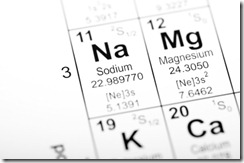Magnesium plays a role in more than 300 enzymatic reactions and is involved in energy metabolism, cellular metabolism, utilization of glucose, synthesis of protein and fatty acids, muscle contractions, all hormonal reactions, neurotransmitter production, and intracellular balance of sodium, potassium and calcium.[1]
The list is long for the consequences of a magnesium deficiency. Magnesium deficiencies can result in hypokalemia (low potassium), alkalosis, hypertension, congestive heart failure, arrhythmia, myocardial infarction, angina pectoris, clotting, atherosclerosis, type 2 diabetes, preeclampsia and other electrolyte deficiencies. [2]
 Magnesium deficiency can be acquired many ways. A decrease in dietary consumption of magnesium has gone from 500mg/day in 1900 to 215-283 mg/day in 1990.[3], [4] It is estimated that the typical dietary intake of magnesium today in the U.S. provides only 35-75% of the recommended daily amount.[5]
Magnesium deficiency can be acquired many ways. A decrease in dietary consumption of magnesium has gone from 500mg/day in 1900 to 215-283 mg/day in 1990.[3], [4] It is estimated that the typical dietary intake of magnesium today in the U.S. provides only 35-75% of the recommended daily amount.[5]
Many over the counter and prescription drugs can influence magnesium nutrient levels and depletion. The list is long, but includes loop and thiazide diuretics, digoxin, carboplatin and cisplatin, corticosteroids, estrogen and oral contraceptives, insulin, proton pump inhibitors, tetracyclines, cyclosporine, laxatives and more.1 Advanced age is also associated with decreased serum and tissue magnesium levels.
Perhaps one of the more common problems with magnesium results in the relationship of calcium and magnesium. High calcium diets or calcium supplementation without attention to magnesium supplementation has been shown to decrease tissue magnesium levels, [6] increase magnesium requirements[7] and decrease magnesium absorption.[8] In individuals with low or suboptimal magnesium status, administration of calcium without concomitant magnesium may further compromise their magnesium status, further increasing their risk of the many of the health risks associated with magnesium insufficiency/deficiency that we have mentioned earlier.
Convenient serum testing for magnesium is usually inadequate because it does not reflect magnesium stores. Less convenient but more accurate testing would include a magnesium-loading test looking at 24-hour urinary magnesium excretion after an infusion of magnesium. Magnesium can also be measured in red blood cells, white blood cells, mononuclear blood cells, and muscle. An intracellular mineral electrolyte panel using cell scrapings under the tongue with electronic photon bombardment technology is available as well.
Supplementing the body’s magnesium stores through oral supplementation takes about six weeks but may be up to six months or more. [9],[10] Many different magnesium salts are available as supplements. Magnesium oxide contains the largest amount of elemental magnesium. Magnesium chloride has high bioavailability. Magnesium may also be bound to aspartate, malate, succinate, fumarate, citrate, gluconate, sulfate and chloride. Some manufacturers assert that magnesium chelated to malate, succinate, fumarate or citrate are better absorbed, utilized and tolerated, but this is variable and not definitive.
Given the prevalence of hypertension, congestive heart failure, arrhythmias, ischemic heart disease, heart attacks and type 2 diabetes in the U.S., magnesium has emerged as a very critical supplement for prevention and management of these conditions. Intervention doses vary from 250 mg/day to 1,000 mg/day depending on the condition, body weight, age, and tolerability. Individuals with kidney disease or heart blocks should not take magnesium unless under a physician’s supervision. Magnesium is generally well tolerated, although there is often a dose limiting amount above which causes loose stool.
Magnesium is an essential mineral for normal body physiology. Deficiencies and insufficiencies are more common than is easily detected, and may lead to numerous cardiovascular disorders, type 2 diabetes, preeclampsia and eclampsia.
In most cases, I recommend that calcium supplementation should also include magnesium supplementation and a ration of approximate 2 parts calcium: 1 part magnesium. Current reference guidelines for daily intake for your age and gender can be obtained from the Institute of Medicine or from www.nutrition.gov. It is important to keep in mind the dietary supplement dosages are in addition to the average daily amount you are getting in your diet, to achieve the recommended daily amount.
References
[1] Dacey M. Hypomagnesemic disorders. Crit Care Clin. 2001;17:155-173.
[2] Gums J. Magnesium in cardiovascular and other disorders. Am J Health-Syst Pharm 2004;61:1569—76.
[3] Kawano Y, Matsuoka H, Takishita S, et al. Effects of magnesium supplementation of hypertensive patients: assessment by office, home, and ambulatory blood pressures. Hypertension. 1998;32:260-5.
[4] Arsenian M. Magnesium and cardiovascular disease. Prog Cardiovasc Dis. 1993; 35:271-310.
[5] Altura B, Altura B. Magnesium and cardiovascular biology: an important link between cardiovascular risk factors and atherogenesis. Cell Mol Biol Res. 1995;41:347-59.
[6] Smith K, Luhrsen K. Trace mineral interactions during elevated calcium consumption. Fed Proc 1986;45:374.
[7] O’Dell BL, Morris ER, Regan WO. Magnesium requirement of guinea pigs and rats. Effect of calcium and phosphorus and symptoms of magnesium deficiency. J Nutr 1960;70:103-111.
[8] Clarkson E, Warren L, McDonald S, de Wardener H. The effect of a high intake of calcium on magnesium metabolism in normal subjects and patients with chronic renal failure. Clin Sci 1967;32:11-18.
[9] Hollifield J. Thiazide treatment of hypertension: effects of thiazide diuretics on serum potassium, magnesium, and ventricular ectopy. AmJ Med. 1986;80 (suppl 4A): 8-12.
[10] Whang R, Ham;pton E, Whang D. Magnesium homeostasis and clinical disorders of magnesium deficiency. Ann Pharmacother. 1994;28:220-6.

